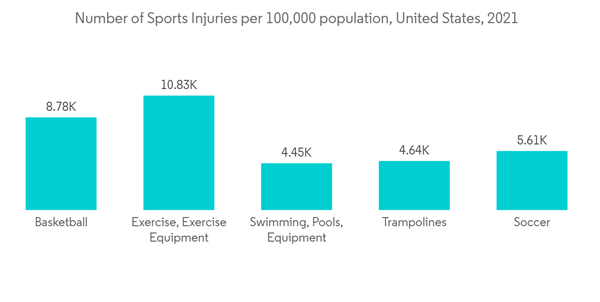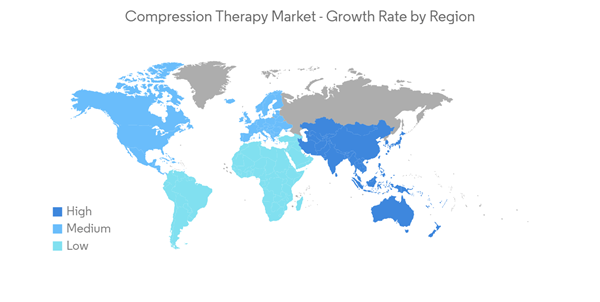The Compression Therapy Market size is estimated at USD 4.01 billion in 2024, and is expected to reach USD 5.29 billion by 2029, growing at a CAGR of 5.70% during the forecast period (2024-2029).
COVID-19 has significantly impacted the growth of the compression therapy market due to the increase in venous disorders caused in hospitalized patients by being in similar positions for a long time during their hospital stay. For instance, according to a study published in the National Library of Medicine, in January 2022, despite sufficient prophylaxis, upper extremity deep vein thrombosis (UEDVT) develops in COVID-19 patients. Furthermore, according to an article published by Contagion Live, in April 2022, the risks of deep vein thrombosis (DVT), pulmonary embolism, and bleeding events were increased by 3 or more months after the COVID-19 infection. Additionally according to The Guardian, in April 2022, COVID-19 was associated with a fivefold increase in the risk of deep vein thrombosis. Thus, with the increase in DVT due to COVID-19, the demand for compression therapy products increased during the pandemic. However, even though the market is gradually stabilizing as COVID-19 cases are declining, there is still an increase in hospital admission, which is expected to impact the market's growth.
Factors such as the growing burden of sports injuries and road accidents, technological advancements in wound management, and growth in the development of preventive and rehabilitative care are significant factors that are expected to drive growth in the market over the forecast period. For instance, according to the study published in the IJERPH, in May 2021, a total of 44% of adolescent athletes who took part in the study suffered an injury in Spain. The most common injuries were lumbar muscle strains (12.24%), ankle sprains (11.98%), and bone fractures (9.31%). Ankles (36.12%), knees (19.32%), and shoulders (6.47%) had the highest concentration of injuries. In all such cases, compression therapy is used to improve blood flow and body movement during the treatment. Furthermore, according to a WHO update, in 2021, rehabilitation is an essential part of universal health coverage along with the promotion of good health, prevention of disease, treatment, and palliative care which include compression therapy. There are several advantages associated with compression therapy, which are anticipated to augment the market's growth.
In addition, strategic activities such as product approval and launches are expected to drive the growth of this market over the forecast period. For instance, in April 2022, Koya Medical launched an active compression system for lymphedema and venous disease. It features a soft, breathable mesh garment with Koya's proprietary Flexframe spring-like segments for delivering compression technology. Such launches in the market will lead to increased adoption by sportspeople and others, driving the market's growth. Thus, the abovementioned factors such as the growing burden of sports injuries and road accidents, and growth in the development of preventive and rehabilitative care are expected to drive the market. However, the availability of alternative treatments and negligence, and lack of awareness regarding compression therapies are the factors expected to restrain the market growth.
Compression Therapy Market Trends
Compression Garments Segment is Expected to Witness High Growth Over the Forecast Period
Compression garments have been widely used in medical treatments. In many sportswear, it is an important addition to athletics and fitness activities. It is expected to enhance the performance of the athletes, decrease the possibility of injury, and accelerate the recovery process. In many burn cases, compression garments are very helpful in minimizing the formation of hypertrophic scars and enhancing the maturation process of scars. Furthermore, according to the study published in BMC Sports Science, Medicine and Rehabilitation, in March 2021, all athletes in the study utilized compression garments primarily to avoid injury recurrence, but they also utilized them to alleviate the symptoms of a present sports injury. Most athletes said the compression garments had a beneficial effect on them. Compression garments were utilized more during athletic involvement than afterwards. Thus, the adoption of compression garments in sports activities and after injuries are expected to drive segmental growth.
In addition, a rise in initiatives from the key market players to adopt the latest technology in compression therapy garments will lead to increased adoption of these products, thereby driving the growth of this segment. For instance, in March 2022, the "Move Skin" Spring and Summer 2022 collection from Danskin (by Goldwin Ltd. Japan) was introduced online and in several retail locations. This is the first collection in Japan to incorporate LYCRA FitSense technology, a water-based dispersion screen printed onto LYCRA fiber stretch clothing to offer lightweight, tailored support. Therefore, owing to the abovementioned factors, this segment is expected to witness robust growth during the forecast period.
North America is Expected to Dominate the Compression Therapy Market Over the Forecast Period
North America is expected to hold a significant share in terms of revenue generation over the forecast period. Some primary reasons include good awareness regarding early diagnosis of venous ulcers, arthritis, sports injuries, and patients suffering from road accidents. For instance, as per the 2021 statistics by the Brain Injury Research Institute, about 1.6 million to 3.8 million recreation and sport-related concussions occur each year in the United States. Furthermore, according to Sports Injury Statistics update 2022, in the United State, out of 30 million children and teens participate in organized sports, more than 3.5 million injuries occur each year, which cause some loss of time of participation. Hence, the rising number of sports injuries in this region will lead to increased adoption of compression therapy during the healing of injuries, thereby driving the market growth in this region.
Additionally, companies are engaged in partnerships, collaborations, acquisitions, mergers, and product launches to innovate in the telemedicine market driving growth in the forecast period. For instance, in January 2022, AIROS Medical, Inc., a designer, manufacturer, and distributor of compression therapy devices, and Fist Assist Devices, LLC (Fist Assist), an innovative medical device company, launched an e-commerce website, for the sale of the Fist Assist FA-1 compression device in the United States. This will increase sales of compression therapies via online platforms, driving market growth in this region. Thus, owing to the abovementioned factors, the market is expected to show growth in the North American region.
Compression Therapy Industry Overview
The compression therapy market is moderate in nature due to the presence of companies operating globally as well as regionally. The competitive landscape includes an analysis of international as well as local companies which hold significant market shares and are well known including 3M, Paul Hartmann AG, Smith & Nephew PLC, Medline Industries, DJO Global, and Bio Compression Systems, Inc., among others.
Additional Benefits:
- The market estimate (ME) sheet in Excel format
- 3 months of analyst support
This product will be delivered within 2 business days.
Table of Contents
Companies Mentioned (Partial List)
A selection of companies mentioned in this report includes, but is not limited to:
- 3M Company
- Arjohuntleigh
- Bio Compression Systems, Inc.
- DJO Global, Inc. (Colfax Corporation)
- Gottfried Medical, Inc.
- Medline Industries, Inc.
- BSN medical
- Paul Hartmann AG
- Smith & Nephew PLC
- medi GmbH & Co. KG
- Tactile Medical
- SIGVARIS (Switzerland)
- Julius Zorn GmbH
- Theragun, Inc. (Therabody)
Methodology

LOADING...










